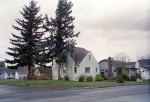Jan
21
2018

Somewhere along the line I acquired a roll of Kodak Advantix 400 B&W film. This film is not truly a black and white film but is processed in C41 colour chemistry. That’s perfect because that’s what I do. The film was likely long out of date and the result was quite thin negatives but I was able to tease enough out of them to make the whole endeavor worth while.
Discover your artistic capabilities. The elegant appeal of black-and-white photography continues to grow. Black-and-white film lends itself to helping you learn the graphic elements of an image—the form, texture, and contrast of a scene. This may take some practice. learning to “see” things in shades of gray. But once you do, you can capture a stunning palette of different moods, emotions, and possibilities. -Kodak
The camera I chose to use for this film was the Canon Elph Jr. with its 26mm four element f2.8 lens. Its hard to believe how small this camera is until you hold it, (weighing a paltry 125g) which is of course what the intention of APS film was despite its brief existence. The Elph Jr. also had a useful shutter range of 2 sec. to 1/800 sec.
no comments | posted in Cameras, Photography
Jan
14
2018

The Canon Photura, also know as the Autoboy Jet, 
looks like its purpose is to answer the question ‘What would happen if you just put a handstrap on an SLR lens and called it a camera?’ Its design seems to have more in common with a camcorder than a film camera but on the end of the lens is just the ordinary insides of a 35mm point and shoot. The lens is a 35-105mm f/2.8-6.6 (10 elements in 9 groups) which is quite a bit faster than other point and shoot zoom cameras. The flash is built into the cap and provides a nice large defuser unfortunately I didn’t get to test its capabilities. Another item that’s there but I didn’t test is the low angle viewfinder mostly because it seems to require putting your eye nearly to it which sort of defeats the purpose in my opinion. 
Also at 645grams and given its size it doesn’t seem to offer much of an advantage over a small SLR with a kit lens but it sure does look different. Other interesting cameras in the same, build it around the lens, vein are the Minolta Freedom Zoom 105i and the much more conventional looking Olympus IS-10
no comments | posted in Cameras, Photography
Jan
7
2018

While I’ve used the Yashica T4 previously I had not had an opportunity to use a T4 zoom which in reality does not bear many similarities. As soon as you go from a fixed focal length to a zoom lens they are going to be different animals. The T4 zoom has a 28-70mm f4.5 to f8.0 lens comprised of seven elements in six groups while the T4 had a 35mm f3.5 lens of four elements There are a few different things you can do with the controls one of which is to set the time and date and its format. This is done while the camera is off which I did not discover until I had imprinted most of my images with a completely erroneous value (That’s okay because I was really just making sure it even worked). Also when off you can alter the focus to spot by pressing the ‘main button’ until [S] is displayed on the LCD, this is reset once the camera is turned off again. When turned on though you can set exposure compensation of +1.5 or -1.5EV, suppress the flash and set a very interesting long exposure mode. This mode is entered by pressing the timer/remote button until [LT] is displayed on the LCD. Once this is done and the camera is secured, pressing the shutter button will result in a 2 second delay, to help reduce shake, followed by up to 120 seconds of exposure time which can be interrupted with a second shutter button press.
This first foray out of the way I’m going to feed the camera some better film and give it a more extensive try. The images that I did get suggest that the lens is a decent performer across the entire frame especially given that its a zoom.
1 comment | posted in Cameras, Photography





























































